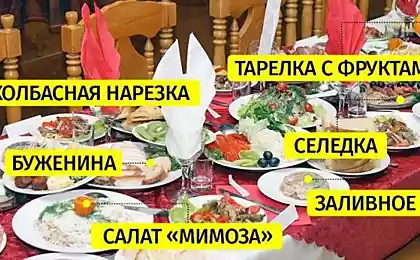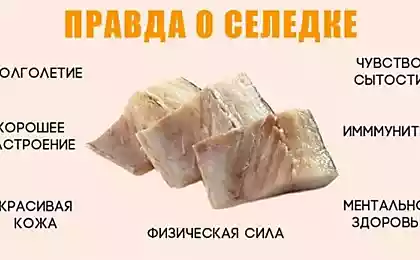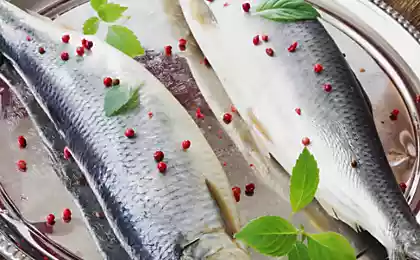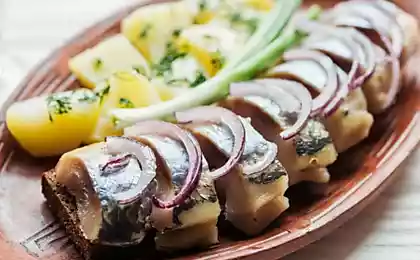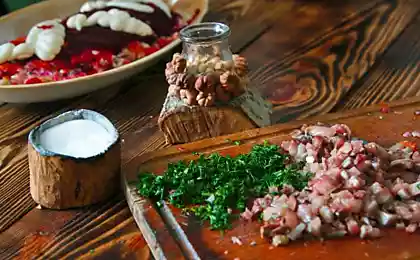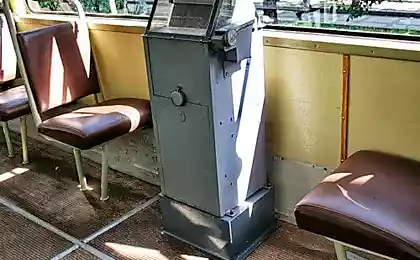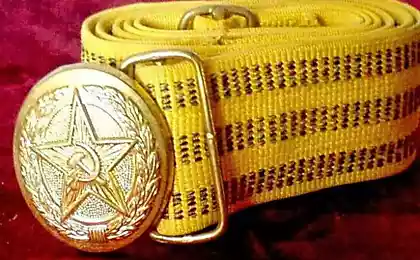1582
Where was gone, herring?
Once, as a child,
when my mother bought, so beloved by me,
", Herring," I asked my mother a funny question:
- Herring - name,
and Ivasi - is her name so?
It was necessary to me to live for many years, that would be another collapsed my childhood imagination.
"Ivasi", it turns out - is not a name, and the brand, brand.
A herring does not even herring and sardines!
So, first things first. And just about where the circus had gone gone ", herring" from our shelves.
Will the 15 images and text
Collected from various sources in the Internet © CTPAHnic
1.
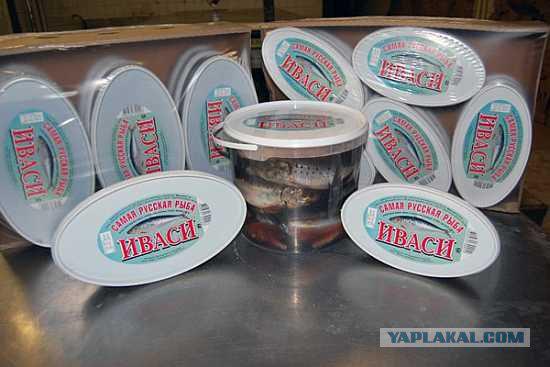
Far Eastern sardine (lat. Sardinops sagax melanosticta) - subspecies of the Pacific sardine sardinops (Sardinops sagax).
Although it belongs to the herring, strictly speaking, it is not a herring.
Trade Name ", herring" gained through resemblance to the herring and sole Japanese species name "ma-iwashi" (in Japanese iwashi literally means "sardine»).
2. That such a bank was considered a true, herring

Encyclopedia on this occasion said: "Ivasi, Far Eastern sardine (Sardinops sagax melanosticta), fish the herring family. It was the main target species in the Far East. Then he suddenly disappeared. It is small and is produced in small quantities ».
More recently, sardines iwashi ranked second in the catches of our fishing fleet in the Far East. It catches in recent years, reaching 600 thousand tons. This fish is common in the vast area - from the coast of the island of Taiwan to the northern part of the Tatar Strait and the coast of eastern Kamchatka.
Often (and completely wrong) sardine iwashi called herring. Ivasi, although part of the vast family of herring fish is only the nearest relative of this Pacific herring, and belongs to a different genus - sardinops. It is medium-sized, not to exceed 25 cm in length, fish. The whole look iwashi says that this is a good swimmer, all the time conducting in motion. After spawning, which takes place in December - May, along the Japan Sea and the Pacific coast of Japan adults they flock to the north. The speed of movement of shoals of 20-30 km per day. Off the coast of Primorye iwashi fattened planktonic crustaceans. Return migration to the south begins in the fall, with a decrease in water temperature up to 8 ° C.
Sardine iwashi live up to 7 years, but the basis of its fisheries are 2-5-year olds. This form is subject to drastic changes in the number of: before the war caught him in large numbers, and in 1941 for a long time, he stopped coming to the shores of Primorye. Currently, the number of true sardine declined sharply and again for a long time disappeared from store shelves this popular tasty fish.
Ie it cyclically as locusts appear in our waters, then disappears. Back in the early 80's we catch this joy in the Amur Bay, just not on a bare hook.
3.

Sardina (lat. Clupea pilchardus, Val.) Small marine fish (usually 1520 cm, rarely up to 25 cm in length) from the seeds. herrings (Clupeidae) suborder physostomous (Physostomi) detachment bony (Teleostei). Sardine slightly thicker herring. The back of her blue-green, sides and belly silvery white. Gill cover with golden shimmer and grooved dark stripes like rays radiating from the lower back and the edge of it.
Sardines is found in the Atlantic Ocean and the Mediterranean Sea and is caught mainly off the coast of England, France, Spain and Portugal. Scales in Sardinia is quite large and difficult descended. In the living as it is one of the most beautiful fish: on the back you can see the tides of several colors of the rainbow. Lifestyle sardines poorly understood: it is known only that the summer Sardines from the depths of the sea beyond the shores of the countries located along the shore of the Atlantic Ocean in a very short time, and then disappears again
4. This sardines
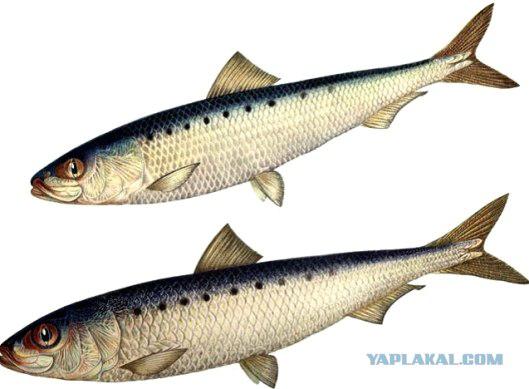
Herring, Herring (lat. Clupea) kind of fish from the herring family (lat. Clupeidae).
Body laterally compressed, with a serrated edge of the belly. Scales of moderate or large, rarely fine. The upper jaw is not given for lower. Mouth moderate. Teeth, if any, rudimentary and dropping. Communicating fin of moderate length and is less than 80 rays. The dorsal fin of the abdominal. The caudal fin is forked. This genus includes 60 species, distributed in the seas of the temperate and hot and partly cold zone.
. The most important common Herring (Cl. Harengus;). The nearest to it kind of sprat (Cl. Sprattus), it is characterized in that 1) the base of the anal fin of less than 3/4 the distance from the pelvic fins to the junction of the maxilla with intermaxillary (sprat have more) and 2) the ventral edge of teeth 3648 (for sprat 3235). Generally, these two types are connected to a plurality of intermediate forms. Maximum length (Norwegian and Swedish) to 37 cm and 42 cm. The color of the back of the steel-blue with green and golden shade, sides and belly silvery, dorsal and tail fin is dark, the other whitish.
Scope: North. Atlantic Ocean (both at the European and North American coasts) in the north to the south of Greenland and Finnmark, in the south to the Bay of Biscay. The Baltic Sea with its bay (which is kind of small, called herring), Finnmarken and the Murmansk coast and the White Sea (mainly in the western and southern coast).
Apparently herring spends most of his life at great depths. Ocean fishing in Europe it begins each year around the Scottish Islands, where it begins a region of relatively shallow water, and gradually moves further and further to the south.
5. This herring or herring in the vernacular.

Relatives of herring from the numerous small. It sprat, sprat, anchovy, herring, sprat, anchovy, sardine. Their kinship quite confusing even for professionals. And for the consumer case is complicated by the fact that biologists and rybopererabotchikov under the same names appear different fish. So, for the ichthyologist sprat - it is Sprattus sprattus, small, up to 17 cm, the fish, which is found in the North Atlantic, Baltic, Mediterranean and Black Seas. And for the processor - any small herring fish, smoked and rolled up in a jar with oil. Most often, for the manufacture of canned "sprats in oil" is used herring Clupea harengus membras, which is actually a real herring, only a small, Baltic subspecies. And this sprat otherwise called "Baltic sprat».
6. Bank sprat may be of sprat
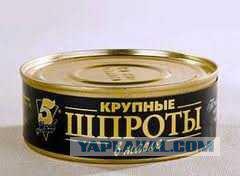
So if you will be bored at the table, you can examine the fish, filed for a snack: at sprat, as well as all of sprat, on the belly has sharp keeled scales, while the herring does not. Not finding these scales on smoked fish from a jar labeled "Sprat" can safely write a complaint to the Society of Consumer Protection, but just make sure that the manufacturer does not insure - I'm on the bank of the Latvian sprat pate, where the identification of the scales can not speak, read "made Baltic herring and sprat. " And on the banks of a herring in tomato sauce, and there is now a second name "Baltic herring". Lives herring up to 6-7 years. Among the usual herring across the so-called giant, growing much faster and reach a length of 37 cm. While the usual herring feeds on plankton, giant herring - a predatory fish, often feeding stickleback.
7. This is a real sprat, still alive
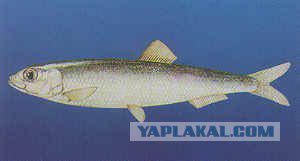
Also sprat Baltic sprat Black Sea there and even New Zealand. But not only called sprats sprats genus Sprattus, but tyulek kind Clupeonella. One type of sprats-tyulek S.engrauliformis called anchovies anchovy. In addition to her, under the exotic name "anchovy" appears a lot of different fish, including anchovy.
8. Anchovy

Otherwise, anchovy Engraulis encrasicolus called "European anchovy." Highest European anchovy is no longer the family of herrings (Clupeidae), and family anchousovyhEngraulidae. This fish can grow up to 20 cm. It is found in the Atlantic, from Norway to South Africa, is in the Mediterranean, Black and Azov Seas. Through the Suez Canal climbed European anchovy in the Indian Ocean and recorded off Somalia and the Seychelles.
9. Hamsa
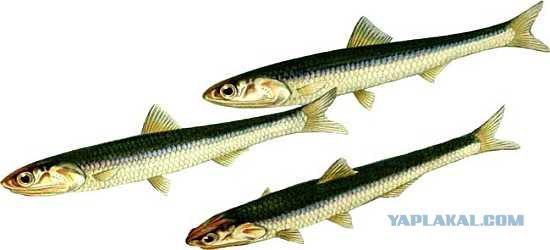
Anchovy - small fish, but very fat, fat in it can be up to 28%. Properly pickled anchovy is very tasty. Even in ancient times salted anchovies valued and used to prepare spicy sauce is a favorite condiment of Greek and Roman gastronomes. But what is "anchovy" for modern cooking? Under this name it is known three kinds of products from herring fish:
1. Herring, a few months matured in intact form in brine with spices. Already in it to cut a shift to a different sauce with a small amount of ammonium nitrate to the flesh it was red and cut into slices.
2. Small small herring or herring placed for several days in the brine immediately after harvest. In two weeks of its shift to a new brine and then put into barrels in rows without the liquid, pouring coarse salt with spices. It is kept for four months at a temperature of plus four degrees and sent without cutting into sales.
10. Under Ukrainian herring - Oseledets

European sardine lives in the northern part of the Atlantic Ocean from Iceland to Senegal, in the Mediterranean Sea (mostly in the western part) and in the Black Sea. Reaches a length of 25 cm. It is caught and canned in Morocco, Spain and Portugal, less than in France, Italy, Algeria. Sardine population is variable, great catches sometimes replaced the next year is very scarce.
11. Sardine (now we have you know that this is correct) Ivasi
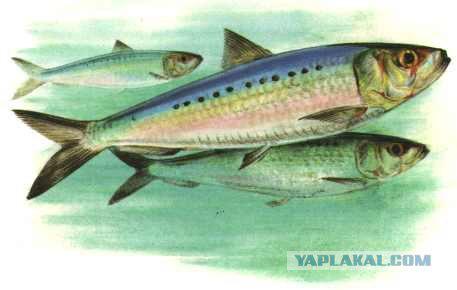
But in the shops more often more common sardine. The greatest practical importance sardinella alasha or round sardinella (S. aurita). In the Mediterranean alasha held mainly in its southern shores, but podlhodit in small quantities and to the north.
12. Sardinella

So, herring - it is herring, sprat - is sprat, sprats - a sprat, sprats - a sprat, sprat - almost anchovy and anchovy - this anchovies, anchovy - a sardine, pilchard - is sardinops and sardinops - is, herring. With herring began, herring and finished.
Confused? Not fear. The main thing that needs to know even a layman: herring and its relatives - a great appetizer.
13. Soviet model fish store. Guess where the fish is what?
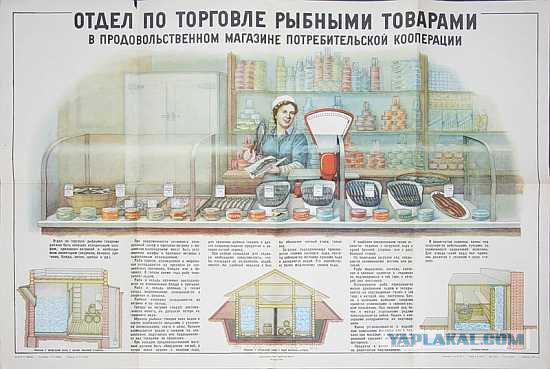
And finally, a couple of recipes. How to Ivasi can do at home. Although the herring, although of pink salmon, even with the excuse of sprat sprat
1) HERRING SALTED
Ingredients:
Herring - 1-2 pieces.
Brine:
1 l. Water
4 tbsp salt
1 tbsp. l. sugar
1/2 tsp vinegar
Pepper
Carnation
Bay leaf
Immediately warn. If you want to eat a herring in itself, then you can use in all of the above pickle spices and seasonings. If you are going to do next, "coat", mincemeat or something in that spirit, it is best not to throw the last three ingredients from the list.
The brine to boil (the vinegar to pour at the time off), to cool and put in a herring (entirely) for 24 hours.
14.
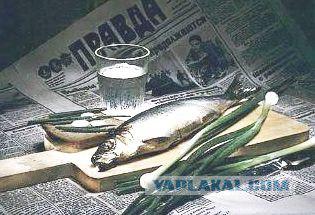
2) HERRING MARINATED
Herring (by the way, salmon get no worse), you can not completely defrosted, cleaned, washed, cut into pieces a la carte. Better, of course, immediately remove the peel and remove the bones (but it is possible and so). Sliced fish put in a bowl or pan in layers. Each layer sprinkled with salt (preferably insufficient salting, this thing can be fixed and then), sugar (a little less than salt), black ground allspice and bay leaf. Laying out all the fish, mix well. Cover slightly smaller than the diameter of the cookware, slightly crushing, and put a period not less than 10 hours, but no more than a day, on the window sill (but not in the refrigerator). After the above-mentioned time, remove the lid and add to taste (if it will be necessary), salt, sugar. And it is mandatory to add:
- Onions, cut into rings (the larger the quantity, the better),
- Vinegar,
- sunflower oil.
All mix well and refrigerate. After a few hours of your goldfish own mother does not recognize.
Delicious - incredibly!
15. Bon appetit. This is the last picture. You can post comments and share recipes.
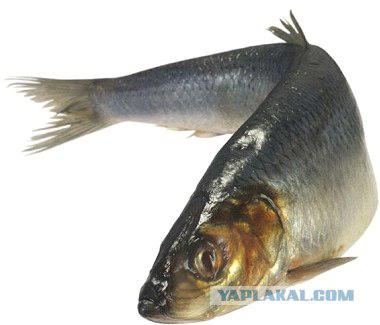
Source:
when my mother bought, so beloved by me,
", Herring," I asked my mother a funny question:
- Herring - name,
and Ivasi - is her name so?
It was necessary to me to live for many years, that would be another collapsed my childhood imagination.
"Ivasi", it turns out - is not a name, and the brand, brand.
A herring does not even herring and sardines!
So, first things first. And just about where the circus had gone gone ", herring" from our shelves.
Will the 15 images and text
Collected from various sources in the Internet © CTPAHnic
1.

Far Eastern sardine (lat. Sardinops sagax melanosticta) - subspecies of the Pacific sardine sardinops (Sardinops sagax).
Although it belongs to the herring, strictly speaking, it is not a herring.
Trade Name ", herring" gained through resemblance to the herring and sole Japanese species name "ma-iwashi" (in Japanese iwashi literally means "sardine»).
2. That such a bank was considered a true, herring

Encyclopedia on this occasion said: "Ivasi, Far Eastern sardine (Sardinops sagax melanosticta), fish the herring family. It was the main target species in the Far East. Then he suddenly disappeared. It is small and is produced in small quantities ».
More recently, sardines iwashi ranked second in the catches of our fishing fleet in the Far East. It catches in recent years, reaching 600 thousand tons. This fish is common in the vast area - from the coast of the island of Taiwan to the northern part of the Tatar Strait and the coast of eastern Kamchatka.
Often (and completely wrong) sardine iwashi called herring. Ivasi, although part of the vast family of herring fish is only the nearest relative of this Pacific herring, and belongs to a different genus - sardinops. It is medium-sized, not to exceed 25 cm in length, fish. The whole look iwashi says that this is a good swimmer, all the time conducting in motion. After spawning, which takes place in December - May, along the Japan Sea and the Pacific coast of Japan adults they flock to the north. The speed of movement of shoals of 20-30 km per day. Off the coast of Primorye iwashi fattened planktonic crustaceans. Return migration to the south begins in the fall, with a decrease in water temperature up to 8 ° C.
Sardine iwashi live up to 7 years, but the basis of its fisheries are 2-5-year olds. This form is subject to drastic changes in the number of: before the war caught him in large numbers, and in 1941 for a long time, he stopped coming to the shores of Primorye. Currently, the number of true sardine declined sharply and again for a long time disappeared from store shelves this popular tasty fish.
Ie it cyclically as locusts appear in our waters, then disappears. Back in the early 80's we catch this joy in the Amur Bay, just not on a bare hook.
3.

Sardina (lat. Clupea pilchardus, Val.) Small marine fish (usually 1520 cm, rarely up to 25 cm in length) from the seeds. herrings (Clupeidae) suborder physostomous (Physostomi) detachment bony (Teleostei). Sardine slightly thicker herring. The back of her blue-green, sides and belly silvery white. Gill cover with golden shimmer and grooved dark stripes like rays radiating from the lower back and the edge of it.
Sardines is found in the Atlantic Ocean and the Mediterranean Sea and is caught mainly off the coast of England, France, Spain and Portugal. Scales in Sardinia is quite large and difficult descended. In the living as it is one of the most beautiful fish: on the back you can see the tides of several colors of the rainbow. Lifestyle sardines poorly understood: it is known only that the summer Sardines from the depths of the sea beyond the shores of the countries located along the shore of the Atlantic Ocean in a very short time, and then disappears again
4. This sardines

Herring, Herring (lat. Clupea) kind of fish from the herring family (lat. Clupeidae).
Body laterally compressed, with a serrated edge of the belly. Scales of moderate or large, rarely fine. The upper jaw is not given for lower. Mouth moderate. Teeth, if any, rudimentary and dropping. Communicating fin of moderate length and is less than 80 rays. The dorsal fin of the abdominal. The caudal fin is forked. This genus includes 60 species, distributed in the seas of the temperate and hot and partly cold zone.
. The most important common Herring (Cl. Harengus;). The nearest to it kind of sprat (Cl. Sprattus), it is characterized in that 1) the base of the anal fin of less than 3/4 the distance from the pelvic fins to the junction of the maxilla with intermaxillary (sprat have more) and 2) the ventral edge of teeth 3648 (for sprat 3235). Generally, these two types are connected to a plurality of intermediate forms. Maximum length (Norwegian and Swedish) to 37 cm and 42 cm. The color of the back of the steel-blue with green and golden shade, sides and belly silvery, dorsal and tail fin is dark, the other whitish.
Scope: North. Atlantic Ocean (both at the European and North American coasts) in the north to the south of Greenland and Finnmark, in the south to the Bay of Biscay. The Baltic Sea with its bay (which is kind of small, called herring), Finnmarken and the Murmansk coast and the White Sea (mainly in the western and southern coast).
Apparently herring spends most of his life at great depths. Ocean fishing in Europe it begins each year around the Scottish Islands, where it begins a region of relatively shallow water, and gradually moves further and further to the south.
5. This herring or herring in the vernacular.

Relatives of herring from the numerous small. It sprat, sprat, anchovy, herring, sprat, anchovy, sardine. Their kinship quite confusing even for professionals. And for the consumer case is complicated by the fact that biologists and rybopererabotchikov under the same names appear different fish. So, for the ichthyologist sprat - it is Sprattus sprattus, small, up to 17 cm, the fish, which is found in the North Atlantic, Baltic, Mediterranean and Black Seas. And for the processor - any small herring fish, smoked and rolled up in a jar with oil. Most often, for the manufacture of canned "sprats in oil" is used herring Clupea harengus membras, which is actually a real herring, only a small, Baltic subspecies. And this sprat otherwise called "Baltic sprat».
6. Bank sprat may be of sprat

So if you will be bored at the table, you can examine the fish, filed for a snack: at sprat, as well as all of sprat, on the belly has sharp keeled scales, while the herring does not. Not finding these scales on smoked fish from a jar labeled "Sprat" can safely write a complaint to the Society of Consumer Protection, but just make sure that the manufacturer does not insure - I'm on the bank of the Latvian sprat pate, where the identification of the scales can not speak, read "made Baltic herring and sprat. " And on the banks of a herring in tomato sauce, and there is now a second name "Baltic herring". Lives herring up to 6-7 years. Among the usual herring across the so-called giant, growing much faster and reach a length of 37 cm. While the usual herring feeds on plankton, giant herring - a predatory fish, often feeding stickleback.
7. This is a real sprat, still alive

Also sprat Baltic sprat Black Sea there and even New Zealand. But not only called sprats sprats genus Sprattus, but tyulek kind Clupeonella. One type of sprats-tyulek S.engrauliformis called anchovies anchovy. In addition to her, under the exotic name "anchovy" appears a lot of different fish, including anchovy.
8. Anchovy

Otherwise, anchovy Engraulis encrasicolus called "European anchovy." Highest European anchovy is no longer the family of herrings (Clupeidae), and family anchousovyhEngraulidae. This fish can grow up to 20 cm. It is found in the Atlantic, from Norway to South Africa, is in the Mediterranean, Black and Azov Seas. Through the Suez Canal climbed European anchovy in the Indian Ocean and recorded off Somalia and the Seychelles.
9. Hamsa

Anchovy - small fish, but very fat, fat in it can be up to 28%. Properly pickled anchovy is very tasty. Even in ancient times salted anchovies valued and used to prepare spicy sauce is a favorite condiment of Greek and Roman gastronomes. But what is "anchovy" for modern cooking? Under this name it is known three kinds of products from herring fish:
1. Herring, a few months matured in intact form in brine with spices. Already in it to cut a shift to a different sauce with a small amount of ammonium nitrate to the flesh it was red and cut into slices.
2. Small small herring or herring placed for several days in the brine immediately after harvest. In two weeks of its shift to a new brine and then put into barrels in rows without the liquid, pouring coarse salt with spices. It is kept for four months at a temperature of plus four degrees and sent without cutting into sales.
10. Under Ukrainian herring - Oseledets

European sardine lives in the northern part of the Atlantic Ocean from Iceland to Senegal, in the Mediterranean Sea (mostly in the western part) and in the Black Sea. Reaches a length of 25 cm. It is caught and canned in Morocco, Spain and Portugal, less than in France, Italy, Algeria. Sardine population is variable, great catches sometimes replaced the next year is very scarce.
11. Sardine (now we have you know that this is correct) Ivasi

But in the shops more often more common sardine. The greatest practical importance sardinella alasha or round sardinella (S. aurita). In the Mediterranean alasha held mainly in its southern shores, but podlhodit in small quantities and to the north.
12. Sardinella

So, herring - it is herring, sprat - is sprat, sprats - a sprat, sprats - a sprat, sprat - almost anchovy and anchovy - this anchovies, anchovy - a sardine, pilchard - is sardinops and sardinops - is, herring. With herring began, herring and finished.
Confused? Not fear. The main thing that needs to know even a layman: herring and its relatives - a great appetizer.
13. Soviet model fish store. Guess where the fish is what?

And finally, a couple of recipes. How to Ivasi can do at home. Although the herring, although of pink salmon, even with the excuse of sprat sprat
1) HERRING SALTED
Ingredients:
Herring - 1-2 pieces.
Brine:
1 l. Water
4 tbsp salt
1 tbsp. l. sugar
1/2 tsp vinegar
Pepper
Carnation
Bay leaf
Immediately warn. If you want to eat a herring in itself, then you can use in all of the above pickle spices and seasonings. If you are going to do next, "coat", mincemeat or something in that spirit, it is best not to throw the last three ingredients from the list.
The brine to boil (the vinegar to pour at the time off), to cool and put in a herring (entirely) for 24 hours.
14.

2) HERRING MARINATED
Herring (by the way, salmon get no worse), you can not completely defrosted, cleaned, washed, cut into pieces a la carte. Better, of course, immediately remove the peel and remove the bones (but it is possible and so). Sliced fish put in a bowl or pan in layers. Each layer sprinkled with salt (preferably insufficient salting, this thing can be fixed and then), sugar (a little less than salt), black ground allspice and bay leaf. Laying out all the fish, mix well. Cover slightly smaller than the diameter of the cookware, slightly crushing, and put a period not less than 10 hours, but no more than a day, on the window sill (but not in the refrigerator). After the above-mentioned time, remove the lid and add to taste (if it will be necessary), salt, sugar. And it is mandatory to add:
- Onions, cut into rings (the larger the quantity, the better),
- Vinegar,
- sunflower oil.
All mix well and refrigerate. After a few hours of your goldfish own mother does not recognize.
Delicious - incredibly!
15. Bon appetit. This is the last picture. You can post comments and share recipes.

Source:

